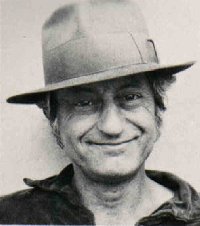"Memories of Rolf Cahn, one of your first students, and my flamenco guitar teacher, who first told me about you and your prowess
Since I’ve been practicing a lot of guitar these past years, my thoughts turn occasionally to Rolf Cahn, who several years ago I learned had died in the 90s. But just today I googled him, and found a couple of articles about him, written in or around 1994, the year he died. I think you’d find them interesting if you hadn’t checked them out before."
He said I was wasting my life going to school and set up a meeting with a visiting officer of the Israeli army who tried to recruit me to train their troops in karate! I was tempted by the money offered, but decided to finish college before making any career moves. I found this clip on the net:
Rolf Cahn
| "Rolf was an outlaw, or rather, he was a lawmaker. It was six months before I was able to understand his lingo and another year before I could follow his craft of coffee making. He was a master of both creation and destruction.
Rolf’s thumbnails, his only manicured part, were kept long for two reasons – boogie bass lines and blinding opponents. Within Rolf’s words, guitar lines, left hooks, and coffee-making rig lived a mastery of the essential." Michael Sheppard |
The Forum topic on the value of repetition of TMA movements has evolved into a mostly friendly exchange of viewpoints and finally even I jumped into the Frey.
Before sharing this with the thousands of you who for some reason or other don’t venture onto the forums, I wanted to highlight one example of a universally respected senior martial artist who has spent nearly all of his life performing his Uechi-ryu in a highly structured and obviously effective manner. Striving for perfection in being able to reproduce the same quality, power and energy in every movement has become the trademark of Toyama sensei.
I’ve seen his Sanseiryu both in person and in film at least a hundred times and I would venture to say unless you had the equipment to analyse his movements with a microscope, there hasn’t been any deviation in the way he performs it from the mid 50s, when he performed it as a young man to the one he did on film last year.
If I believed that anything I was teaching was harmful to my students, I would not be including it in my class.
Probably given enough time and students, I could come up with a valid
method for determining what should be included and what wasn’t needed.
However,
after teaching so many students from all walks of life and a thousand
other variables, the TMA program (in my estimation) works pretty damn
well.
Again, it depends what (as a teacher) I’m trying to
accomplish. And of course, what my students wish to accomplish and what
natural abilities they have and the mindset/time/focus they are willing
to put into achieving their goals.
To take someone into your
dojo who simply wants to fight, in the quickest and easiest manner
possible would be a waste of time for both the TMA dojo and student.
There are faster ways to accomplish this and of course, the result will
still be based on the student’s natural ability.
An Art Rabesa
was always a good fighter and I don’t think the TMA training hurt his
ability in any way. (At least he claims it helped him) Jim Maloney was
always a great fighter and believe it or not, he put out a dvd on kyu
and dan kumite! Go figure. 🙂
As I’ve stated so many times in forum discussions:
Show
me your "new" students , not those you’ve "cherry picked" from someone
else’s dojo after 20 years of TMA training, and show me how you have
transformed those new students to make them into what they want to be
in a month 2 months – 6 months and after a year on a diet of "light"
Uechi-ryu!
And most important… Show me you have the ability
to take a new and average student from a clumsy ditz to a credible
black belt who, as a result of your program, has benefited in all ways
from improved health to fighting ability.
I’ve been to the MMA
classes and viewed "all" the students in the class – not just the ones
brought to demonstrations or matches. Guess what? They look just like
the new students in my class.
Give me a class full of Gary
Khourys, Vinny Christianos, Joe Pomfrets and a hundred more who have
gone through the TMA program before embarking on their own Uechi path.
I could have eliminated 75% of the TMA program for these guys and still
would have turned out credible fighters. Did I shortchange them by
forcing dan kumite on them?
I’m in the business of making the
average new student into credible fighters – – or at least making them
better than they were when they walked into the dojo. I’ve been
successful at doing this and unfortunately I’m not smart enough to know
what part or parts of the TMA program I could have eliminated to
accomplish this.
Did the super athletes get "shortchanged" or did they miss or lose something by learning the whole Uechi program?
Did the TMA hurt them in their eventual quest?



